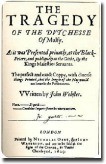The White Devil Contents
The White Devil
John Webster and The White Devil
.jpg) The White Devil has always been a controversial play. It was not well received at its first performance and was hardly performed during the eighteenth and nineteenth centuries. However, it has been appreciated much more since the beginning of the twentieth-century. Its critique of corruption in high places and its presentation of morally ambiguous characters seem to strike a chord with modern audiences.
The White Devil has always been a controversial play. It was not well received at its first performance and was hardly performed during the eighteenth and nineteenth centuries. However, it has been appreciated much more since the beginning of the twentieth-century. Its critique of corruption in high places and its presentation of morally ambiguous characters seem to strike a chord with modern audiences.
The play is seen as part of the genre of revenge tragedy. Yet whilst it is interesting to see it as part of that tradition, in many ways it doesn’t fit well into the genre.
John Webster
|
Context of The White Devil.jpg) John Webster lived in the late 16th and early 17th century. The world of Shakespeare and the Metaphysical Poets
had a profound effect on his writings and provides a lense through which one can better understand the text. Read more . . . John Webster lived in the late 16th and early 17th century. The world of Shakespeare and the Metaphysical Poets
had a profound effect on his writings and provides a lense through which one can better understand the text. Read more . . .
|
Dive in to The White Devil text guide
Synopsis and commentary - Read a scene by scene summary and commentary on The White Devil.
Characterisation - Find out about the main protagonists in the play and analyse their characters.
Themes and significant ideas - Discover the role of Morality, Good and Evil.
Imagery and symbolism - Investigate the imagery of colours throughout the play.
The White Devil e-book - Read the play and research the text, all for free and online.
How to do well in your The White Devil essayDecide what the key words of the question are, and underline them. Want more essay and exam tips? |
Are you a teacher?We have something for you as well! Download free The White Devil teacher materials, ready to be printed and used in class. |
Why study The White Devil?
The play’s modernity
The characters are very much of their time being drawn from the world of Italian aristocrats, church men, courtesans and courtiers. But these characters are also very modern. Characters like Flamineo and Vittoria challenge the status quo as they try to make their way in a world that does them no favours.
The world of seventeenth century Italy that is presented in the play is often a cipher for Webster’s contemporary English society, which he satirises. It is a world that is changing from settled medieval hierarchies to an era that is becoming early modern, with individuals challenging established power bases, religious belief and morality.
The prominence of women
Women are very important in The White Devil. Arguably the most important character is Vittoria, to whom the play’s title refers. She is a complex character who will not accept a traditional role and suffers for it.
Webster invites the audience to consider the place of women in society through the fate of Vittoria, who is presented with a certain amount of sympathy. The other female characters show us women suffering at the hands of men and because of the expectations of society. But they are seen attempting to maintain their integrity and beliefs.
Poetry and struggle
The White Devil is rightly famous for the quality of its language. Rather than memorable soliloquies it has robust dialogue between the characters, exemplified in Vittoria’s trial. The language of the play abounds with the imagery of animals, poisonous plants, corruption, money and trade. This reflects the corrupt and mercenary world of the play.
The abiding effect of the play is of the main characters struggling against events and powerful figures stacked against them, yet maintaining intelligence, courage and often humour in this situation. There is much wickedness and wrongdoing and the characters could hardly be said to offer good moral examples. However, they are always presented in a way that shows their humanity. The oxymoron of ‘white devil’ is a clear indication of this moral complexity.
 John Webster (c.1580 – 1625) was an English playwright and contemporary of William Shakespeare. As well as writing The White Devil he is also well known for his other tragedy, The Duchess of Malfi.
John Webster (c.1580 – 1625) was an English playwright and contemporary of William Shakespeare. As well as writing The White Devil he is also well known for his other tragedy, The Duchess of Malfi. 